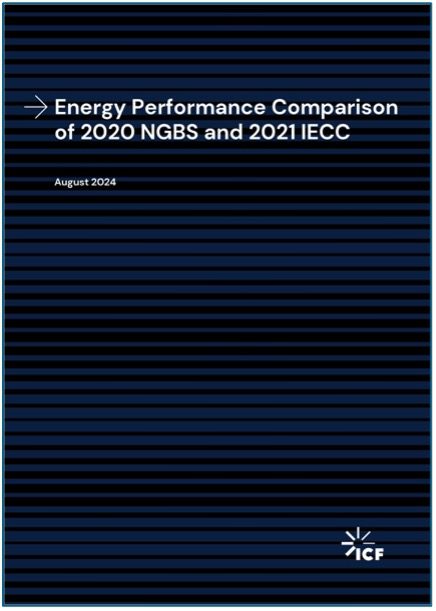
Analysis conducted by ICF consulting compared the home energy performance of the 2020 National Green Building Standard (NGBS), the first residential green building standard to undergo the full consensus process from the American National Standards Institute (ANSI), and the 2021 Residential International Energy Conservation Code (IECC). The analysis showed that the NGBS is not equivalent to the 2021 IECC except possibly at the Emerald level, and all homes at the Bronze, Silver, and Gold levels result in worse energy performance and higher energy costs than the 2021 IECC.
Why Compare the Two Standards?
ICF’s analysis aimed to determine if the NGBS met or exceeded the energy performance of the 2021 IECC. As of April 2024, more than 610,000 housing units have received NGBS certification, with new multifamily housing comprising the bulk of those residences certified. According to Home Innovation Research Labs, single-family homes (new and remodeled) account for 29,903 units.
NGBS Overview
The ICC-700-2020 NGBS is an ANSI-approved standard that uses third-party inspections to certify aspects of buildings at various levels. This voluntary standard, which builders can elect to participate in, was first published in 2008. The 2020 NGBS was developed based on the 2018 IECC (and other I-Codes), and projects that comply with the 2018 IECC were deemed to comply with the energy efficiency requirements of the NGBS Bronze level.
The NGBS includes requirements addressing energy, water, resource efficiency, lot development, operations, maintenance, and indoor environmental quality. ICF’s analysis considered only Chapter 7 of the NGBS, which deals with energy efficiency, when conducting the comparison to the 2021 IECC.
Similar to the 2021 IECC, the NGBS energy efficiency requirements have three compliance options:
Prescriptive Path — (Section 703) requires compliance with specific measures (e.g., insulation, envelope leakage), with limited availability for efficiency tradeoffs.
Performance Path — (Section 702) establishes a reference design against which a proposed home will be benchmarked. This option requires energy modeling software to demonstrate that a home meets or exceeds the reference design.
Energy Rating Index (ERI) Target Path — (Section 704), which relies on energy modeling through ANSI/RESNET/ICC301 to establish an ERI that is equivalent to or lower than (i.e., equal to or more efficient) than the NGBS-specified ERI Target based on Climate Zone.
2021 IECC Overview
The IECC, first published in 1988 by the International Code Council (ICC), established mandatory minimum energy efficiency requirements for new commercial and residential homes. It’s the energy code used by most states and comprises prescriptive and performance-related measures to create an energy efficiency baseline. It includes requirements for the thermal envelope, heating and cooling systems, ventilation, lighting, and water heating.
The IECC is developed on a three-year cycle and contains mandatory provisions that must be met for all buildings, but it also includes three different options for compliance:
Prescriptive Path – (R401-R404, and R408) – Offers compliance through a prescriptive set of efficiency measures that must be met (including insulation and air leakage).
Performance Path (R405) – Allows compliance based on whole-home energy modeling and provides flexibility for tradeoffs.
ERI Pathway (R406) – Relies on energy modeling through ANSI/RESNET/ICC301 to establish an ERI, which is a score that represents the energy efficiency of a home. A home must have an ERI equivalent to or lower than the IECC-specified ERI based on climate zone.
Methodology
ICF’s analysis examined several representative single-family homes using the U.S. Department of Energy’s Methodology for Evaluating the Cost Effectiveness of Residential Energy Code Changes.[1] The homes were located in Houston, TX (Climate Zone 2), Baltimore, MD (Climate Zone 4), and Burlington, VT (Climate Zone 6) and had varied HVAC, fuel, and foundation types.
Researchers used Ekotrope’s Version 4.2.2 as the modeling software because it provides reports that automatically review compliance with the 2021 IECC and the NGBS. The software’s built-in NGBS performance reports compared a home configured to meet the 2021 IECC prescriptive path requirements against NGBS levels.
Results
The analysis showed that compliance with the 2021 IECC results in energy costs roughly equivalent to the NGBS Emerald level. However, the less stringent NGBS levels (Gold, Silver, and Bronze) have negative savings compared to the 2021 IECC, meaning they are less efficient, resulting in higher energy costs.
Conclusion
Even if the 2020 NGBS Reference Homes were updated to the values of the 2021 IECC, “there would still be a significant gap between the outcomes of the two standards,” ICF’s report notes. “Unlike the 2021 IECC, the structure of the 2020 NGBS performance path does not include mandatory insulation levels and allows a significant decrease in core building efficiency in exchange for common improvements in heating, cooling, or water heating equipment that exceeds the federal minimums.”
To download the report, click here.
[1] https://www.energycodes.gov/sites/default/files/2021-07/residential_methodology_2015.pdf
